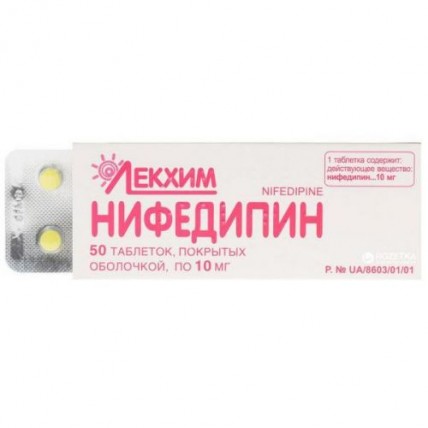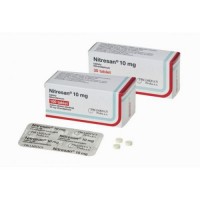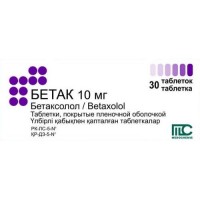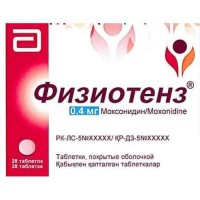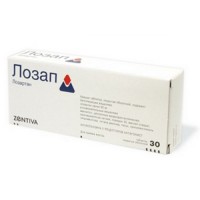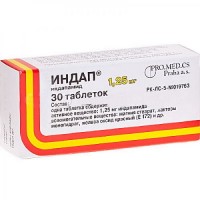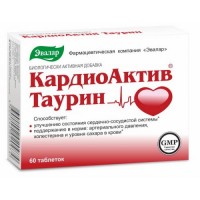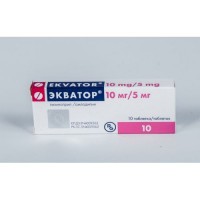Nifedipine 10 mg coated (50 tablets)
- $3.70
Out Of Stock
The instruction for medical use of NIFEDIPINE medicine the Trade name Nifedipine the International unlicensed name Nifedipine Dosage Form of the Tablet, coated, 10 mg and 20 mg Structure One tablet contains active agent: nifedipine – 10 mg or 20 mg, excipients: lactoses monohydrate, potato starch, cellulose microcrystalline, povidone, sodium lauryl sulfate, magnesium stearate, gipromeloz (hydroksipropilmetiltsellyuloz), polysorbate 80, titan dioxide (E 171), polyethyleneglycol 6000, talc, quinolinic yellow (E 104). The description of the Tablet of round shape, with a biconvex surface, coated yellow color. On a break when examining under a magnifying glass the kernel surrounded with one continuous layer is visible. Pharmacotherapeutic group Blockers of calcium channels. Selection blockers of calcium channels with primary action on vessels. Dihydropyridine derivatives. Nifedipine. The ATX C08CA05 code the Pharmacological Pharmacokinetics At properties intake nifedipine quickly and almost completely (more than 90%) is absorbed from digestive tract. Bioavailability – about 50%. The maximum concentration in blood plasma is reached in 1-3 h after reception. Elimination half-life – 2-5 hours. It is removed generally with urine in the form of inactive metabolites. Time of approach of clinical effect: 20 min. – at oral administration, 5 min. – at sublingual. Duration of clinical effect – 4-6 h. Pharmacodynamics Selection blocker of calcium channels, derivative dihydropyridine. Slows down intake of calcium in cardiomyocytes and cells of smooth muscles of vessels. Renders anti-anginal and antihypertensive effects. Reduces a tone of smooth muscles of vessels. Expands coronary and peripheral arteries, reduces the general peripheric vascular resistance, arterial blood pressure and it is insignificant – contractility of a myocardium, reduces an afterload and the need of a myocardium for oxygen. Improves a coronary blood stream. The conductivity of a myocardium does not oppress. At prolonged use, nifedipine can prevent formation of new atherosclerotic plaques in coronary vessels. In an initiation of treatment the passing reflex tachycardia and increase in warm emission which are not compensating the vazodilatation caused by drug can be noted by nifedipine. Nifedipine strengthens removal from an organism of sodium and water. At Reynaud's syndrome drug can warn or reduce an angiospasm of extremities. Indications - arterial hypertension, - coronary heart disease: chronic stable stenocardia, vasospastic stenocardia (Printsmetal's stenocardia). The route of administration and doses the Dose of drug and duration of a course of treatment are established by the doctor individually taking into account severity of a disease and reaction of the patient to treatment. Depending on a clinical picture, in each separate case the main dose should be entered gradually. Patients from the liver broken by function can have a need for careful monitoring of its state, and for hard cases – in a dose decline. For treatment of coronary heart disease it is recommended to accept on 1 (a dosage of 20 mg) or on 2 (a dosage of 10 mg) drug tablets twice a day (40 mg/days). If higher doses of drug are necessary, they should be raised gradually to the maximum dose – 60 mg/days. For treatment of arterial hypertension Nifedipine is recommended to be accepted on 1 (a dosage of 20 mg) or on 2 (a dosage of 10 mg) tablets twice a day (40 mg/days). At simultaneous use of the drug Nifedipine with CYP inhibitors 3A4 or inductors CYP 3A4 there can be a need for dose adjustment of nifedipine or for nifedipine cancellation. In view of the significant anti-ischemic and antihypertensive effect of drug it should be cancelled gradually, especially in case of use high dosed Tablets it is necessary to swallow, washing down with a small amount of liquid. Drug is used irrespective of meal. It is recommended to avoid consumption of grapefruit juice during administration of drug. The recommended interval between use of tablets – 12 hours (not less than 6 hours). Side effects Determination of frequency of by-effects is carried out according to the following criteria: very often (≥ 1/10), it is frequent (≥ from 1/100 to & lt, 1/10), infrequently (≥ from 1/1000 to & lt, 1/100), is rare (≥ 1/10000 to & lt, 1/1000), is very rare (& lt, 1/10000), frequency is unknown (it cannot be defined on the basis of the available data). A class of a system of bodies Often (≥ from 1/100 to & lt, 1/10) Infrequently (≥ from 1/1000 to & lt, 1/100) Seldom (≥ 1/10000 to & lt, 1/1000) Frequency is unknown Disorders from a cardiovascular system the strengthened heartbeat, tachycardia a stethalgia (stenocardia) of Disorder from the system of blood and lymphatic system a leukopenia, Disorder agranulocytosis from nervous system a headache, dizziness paresthesia, a sleep disorder (insomnia, drowsiness, an uneasy dream), a shiver, an ataxia, a loss of consciousness, Disorder migraine from organs of sight reduction of visual acuity Disorder eye pain from organs of hearing and an inner ear a ring in Disorder ears from airways, a thorax and mediastinum congestion of a nose, nasal bleeding dispnoe Disorders from digestive tract a constipation diarrhea, nausea, an abdominal pain, a meteorism, dryness in a mouth, a meteorism a hypertrophy of gums vomiting, intestinal impassability, insufficiency of a gastroesophageal sphincter of Disorder from kidneys and urinary tract a polyuria, Disorder dysuria from skin and hypodermic fabrics an erythema of cheeks (face reddening) of naggers, a small tortoiseshell toksiko-dermal-ny a necrolysis, Disorder purpura from the immune system allergic reactions, a Quincke's disease of naggers, urticaria, rash anafilak-ticheskiye/anaphylactoid reactions of Disorder from the musculoskeletal device and connective tissue the arthritis with existence of positive anti-nuclear antibodies, muscular spasms, hypostases of joints an arthralgia, Disorder myalgia from metabolism and digestion a hyperglycemia (especially at patients with diabetes) Disorders from the vascular system swelled feet, anklebones or shins, Disorder vazodila-tation from a liver and biliary tract tranzitorny increase in activity of enzymes of a liver Disorder jaundice from a reproductive system and mammary glands erectile dysfunction the General disturbances fever, nonspecific pains Mental disorders bad health alarm of the Contraindication - Hypersensitivity to active ingredient or to any of drug components - hypersensitivity to other dihydropyridines - cardiogenic shock - an aortal stenosis of heavy degree - a porphyria - a state during a myocardial infarction or for a month after it - secondary prevention of a myocardial infarction - a combination with rifampicin (because of impossibility to reach effective levels of nifedipine in plasma owing to induction of enzymes) - unstable stenocardia - inflammatory bowel diseases or Crohn's disease - children and teenagers up to 18 years. - faces with hereditary intolerance of fructose, deficiency of Lapp-lactases enzyme, glucose galactose malabsorption Medicinal interactions At simultaneous use of antihypertensive drugs, beta-blockers, diuretic means, nitroglycerine and isosorbide of the prolonged action it is necessary to consider a possibility of synergy effect of nifedipine. Digoxin Nifedipin can increase concentration of digoxin in blood plasma. It is necessary to control concentration of digoxin in blood plasma and to regulate a dose in an initiation of treatment nifedipine at increase in a dose and the termination of treatment by nifedipine. Magnesium sulfate Nifedipin can strengthen toxic effect of magnesium sulfate that leads to neuromuscular blockade. Simultaneous use of nifedipine and magnesium sulfate is dangerous and can threaten the patient's life therefore it is not recommended to use these drugs together. Cimetidinum can lead Simultaneous use of nifedipine and Cimetidinum to increase in concentration of nifedipine in blood plasma and to strengthening of hypotensive effect of nifedipine. Cimetidinum suppresses activity of a tsitokhromny isoenzyme of CYP3A4. Patients who already accept Cimetidinum should apply nifedipine with care and gradual increase in a dose. Hinupristin, dalfopristin can increase the plasma level of nifedipine. Phenytoinum, carbamazepine can lead Use of nifedipine to increase in concentration of carbamazepine and Phenytoinum in blood plasma. Patients who already accept nifedipine and Phenytoinum or carbamazepine at the same time need to be under constant observation of the doctor. In case of signs of toxicity or increase in concentration of carbamazepine and Phenytoinum in blood plasma it is necessary to reduce a dose of these drugs. Quinidine Nifedipin can cause reduction of concentration of quinidine in blood serum whereas quinidine can increase sensitivity of the patient to effect of nifedipine. If to the patient who already accepts quinidine began treatment with nifedipine, it is necessary to pay attention to side effects of nifedipine. It is necessary to control quinidine level in blood serum before an initiation of treatment and in case of the treatment termination by nifedipine, it is also necessary to regulate a quinidine dose. Theophylline At simultaneous use of nifedipine and theophylline concentration of the last in blood plasma can raise, decrease or be left without changes. It is recommended to control concentration of theophylline in blood plasma and, in case of need, to regulate its dose. Rifampicin Simultaneous use of rifampicin and nifedipine can be followed by decrease in concentration of nifedipine in blood plasma and, as a result, reduction of its therapeutic effect. In case of attacks of stenocardia or the increased arterial blood pressure at simultaneous use of nifedipine and rifampicin the dose of nifedipine should be increased. Diltiazem weakens nifedipine dissolution that can cause a dose decline. Vincristinum At a concomitant use of Vincristinum is observed weakening of removal of Vincristinum. Cephalosporin At simultaneous use of nifedipine and cephalosporin occurs increase in level of cephalosporin in plasma. Itrakonazol, erythromycin, klaritromitsin can lead Simultaneous use of nifedipine and an itrakonazol (and also with other azolny antifungal means, erythromycin and klaritromitsiny which slow down action of a tsitokhromny isoenzyme of CYP3A4) to increase in concentration of nifedipine in blood plasma and to strengthening of its action. At emergence of side effects of nifedipine it is necessary to reduce its dose (if it is possible) or to stop use of antifungal means. Cyclosporine, ritonavir or sakvinavir Concentration of nifedipine in blood serum and its action can also amplify at simultaneous use of nifedipine, cyclosporine, a ritonavir or sakvinavir (these drugs slow down action of a tsitokhromny isoenzyme of CYP3A4). At emergence of side effects of nifedipine it is necessary to reduce its dose. Takrolimus At the patients with a transplant of a liver who were at the same time receiving takrolimus and nifedipine, increase in concentration of a takrolimus in blood serum was observed (takrolimus it is metabolized by means of CYP3A4 cytochrome). The importance and clinical consequences of this interaction were not investigated. Fentanyl fentanyl can cause arterial hypotension In patients who apply nifedipine. At least, in 36 hours prior to carrying out planned operation with use of a fentanilovy anesthesia it is necessary to stop nifedipine use. Anticoagulants like coumarin At the patients accepting anticoagulants like coumarin the increase in a prothrombin time after administration of nifedipine was observed. The importance of this interaction was not completely investigated. Metasincaline Nifedipin can change response of bronchial tubes to metasincaline. Treatment by nifedipine should be stopped before carrying out the nonspecific bronkhoprovokatsionny test with metasincaline (whenever possible). Experience of use of the calcic antagonist of a nimodipin demonstrates that for nifedipine the following interactions are not excluded: carbamazepine, phenobarbital – decrease in plasma levels of nifedipine, at a concomitant use of macroleads (in particular erythromycin), fluoxetine, a nefazodon, valproic acid – growth of plasma levels of nifedipine. Igibitora Clinical trials of studying potential of interaction between nifedipine and some inhibitors of HIV protease (for example, ritonaviry) were not carried out by protease anti-HIV. Drugs of this class, as we know, inhibit the system of P450 3A4 cytochrome. Besides, these drugs inhibit in vitro the nifedipine metabolism mediated by P450 3A4 cytochrome. At simultaneous use with nifedipine it is impossible to exclude significant increase in its plasma concentration because of decrease in metabolism of the first passing and decrease in removal from an organism. Azolny antimycotics the Research of interaction between nifedipine and some antifungal drugs of azolny group (for example, ketokonazoly) was not conducted yet. Drugs of this class inhibit the system of P450 3A4 cytochrome. At oral administration along with nifedipine it is impossible to exclude significant increase in its system bioavailability because of decrease in metabolism of the first passing. Simultaneous use of nifedipine and other antihypertensive drugs given below can lead antihypertensive drugs to increase in antihypertensive effect: - diuretics,-β-адреноблокаторы (developing of heart attack in some cases is also possible), - APF inhibitors, - antagonists of angiotenzinovy receptors, - other antagonists of calcium, - α-adrenoblockers, - FDE-5 inhibitors, - α-Methyldopa. Grapefruit juice Grapefruit juice can increase concentration of nifedipine in blood serum and enhance its hypotensive effect and frequency of vazodilatatorny side effects. Use of nifedipine can lead other types of interaction to obtaining lozhnopovyshenny results at spectrophotometric definition of concentration of vanilil-mandelic acid in urine (however at use of a method of highly effective liquid chromatography this effect is not observed). Special instructions Should appoint with extra care Nifedipine the patients who are on a hemodialysis and also patients with malignant hypotension or a hypovolemia (reduction of volume of the circulating blood) as expansion of blood vessels can cause a considerable lowering of arterial pressure. At therapy of a coronary vasomotor spasm in the postinfarction period the treatment by Nifedipine needs to be begun approximately in 3-4 weeks after a myocardial infarction and only on condition of stabilization of coronary circulation. Grapefruit juice oppresses nifedipine metabolism that leads to increase in concentration of the last in blood plasma and to strengthening of hypotensive effect of drug. Use of nifedipine can lead to obtaining lozhnopovyshenny results at spectrophotometric definition of concentration of vanilil-mandelic acid in urine (however at use of a method of highly effective liquid chromatography this effect is not observed). It is necessary to be careful at drug use to patients with the available strong narrowing of digestive tract because of possible emergence of obstructive symptoms. Very seldom there can be bezoara which can demand surgical intervention. In isolated cases obstructive symptoms at absence in the anamnesis of disturbances from digestive tract were described. Patients cannot apply with an ileal and intestinal vessel (ileostomy after a proktokolektomiya). Use of drug can lead to obtaining false positive results at X-ray analysis with use of baric contrast means (for example, defects of filling are interpreted as a polyp). Patients from the liver broken by function need careful monitoring, and hard cases – a dose decline. Nifedipine is metabolized by means of the system of P450 3A4 cytochrome therefore drugs which inhibit or induce this system of enzymes, can change "the first passing" or clearance of nifedipine. To drugs which yav
yatsya by weak or moderate inhibitors of a system of P450 3A4 cytochrome and can lead to increase in concentration of nifedipine in plasma, belong, for example: - makrolidny antibiotics (for example, erythromycin), - protease anti-HIV inhibitors (for example, ritonavir), - azolny antimycotics (for example, ketokonazol), - antidepressants nefazodon and fluoxetine, - hinupristin/dalfopristin, - valproic acid, - Cimetidinum. At simultaneous use of nifedipine with these drugs it is necessary to control arterial blood pressure and in case of need to consider a question of a nifedipine dose decline. Separate experiments of in vitro found interrelation between use of antagonists of calcium, in particular nifedipine, and the reversible biochemical changes of spermatozoa worsening ability of the last to fertilization. In case attempts of fertilization of in vitro are unsuccessful, in the absence of other explanations, antagonists of calcium, for example, nifedipine, can be considered as the possible reason of this phenomenon. Drug should not be used if there is a probability of bonds between the previous use of nifedipine and ischemic pain. At patients with stenocardia the attacks can arise more often, and their duration and intensity can increase, especially in an initiation of treatment. Medicines with active ingredient do not apply nifedipine to patients with a bad attack of stenocardia. Nifedipine use by sick diabetes can demand treatment correction. Special security measures With care appoint drug at very low arterial blood pressure (heavy arterial hypotension with indicators of systolic arterial blood pressure lower than 90 mm Hg.) and also at the significant weakness of warm activity (dekompensirovanny heart failure). In the profound arterial hypotension (systolic pressure is lower than 90 mm Hg.), heavy disturbances of cerebral circulation, the profound heart failure, a heavy aortal stenosis, diabetes, disturbances of functions of a liver and kidneys Nifedipine can be applied only in the conditions of constant clinical observation, avoiding purpose of high doses of drug. To patients of advanced age (60 years are more senior) drug is dosed carefully. Use during pregnancy and feeding by a breast Nifedipine is contraindicated for use during pregnancy for up to the 20th week. Use of nifedipine during pregnancy after the 20th week demands careful individual risk analysis of advantage and has to be considered only if all other options of treatment are impossible or were inefficient. It is necessary to carry out careful monitoring of arterial blood pressure when prescribing nifedipine from magnesium by sulfate intravenously as there is a probability of a sharp lowering of arterial pressure which can be menacing for the woman and a fruit. Nifedipine gets into breast milk. As there are no data on influence of nifedipine on babies, it is necessary to stop feeding by a breast before nifedipine use. Children do not use Drug to children (up to 18 years). Information on excipients Because of monohydrate lactose content as excipient it is careful to appoint the patient with diabetes. The feature of influence of medicine on ability of control of motor transport or potentially dangerous mechanisms At use of drug is not recommended to run vehicles and to work with other potentially dangerous mechanisms. Overdose Symptoms: a headache, hyperaemia of the person, the prolonged system hypotension, lack of pulse on peripheral arteries. In hard cases the tachycardia or bradycardia, dysfunction of sinus node, delay of atrioventricular conductivity, a hyperglycemia, a metabolic acidosis and a hypoxia, collapse with a loss of consciousness and cardiogenic shock which is followed by a fluid lungs, disturbance of consciousness up to a coma are observed. Treatment. Measures for providing emergency aid first of all have to be directed to removal of drug from an organism and restoration of a stable hemodynamics. At patients it is necessary to control constantly functions of cardiovascular and respiratory systems, levels of sugar and electrolytes (potassium, calcium) in blood plasma, a daily urine and volume of the circulating blood. Administration of drugs of calcium is possible. If administration of calcium is insufficiently effective, use of such sympathomimetics as a dopamine or noradrenaline, for stabilization of arterial blood pressure will be reasonable. Doses of these drugs select taking into account the reached medical effect. Bradycardia can be eliminated with use of beta sympathomimetics. At delay of a warm rhythm which threatens life the use of an artificial pacemaker is recommended. It is necessary to approach additional input of the fluid very carefully as at the same time the danger of an overload of heart increases. As high extent of linking with proteins of blood plasma and rather small volume of distribution is characteristic of nifedipine, the hemodialysis is not effective, however carrying out a plasma exchange is recommended. Form of release and packing of the Tablet, coated, 10 mg and 20 mg. On 10 tablets in blister strip packaging from a film polyvinylchloride and material rolled packing on the basis of aluminum foil. On 5 blister strip packagings together with the instruction for medical use in the state and Russian languages in a pack from cardboard. To Store storage conditions in original packing at a temperature not over 25 of 0C. To store out of children's reach! Period of storage 3 years. Not to apply after an expiration date. Prescription status According to the prescription. Technolog CIAO producer. 20300, Ukraine, city of Uman of the Cherkassk region, Manuilsky Street, 8. Name and country of the owner of the registration certificate CIAO Technolog. 20300, Ukraine, city of Uman of the Cherkassk region, Manuilsky Street, 8. The name and the address of the organization in the territory of the Republic of Kazakhstan, the accepting claim (offer) on quality of medicines from consumers and responsible for post-registration observation of safety of medicine: L-Pharma LLP 050061, RK, Almaty, mikr. "Tastak-1"
to Develop house 3
yatsya by weak or moderate inhibitors of a system of P450 3A4 cytochrome and can lead to increase in concentration of nifedipine in plasma, belong, for example: - makrolidny antibiotics (for example, erythromycin), - protease anti-HIV inhibitors (for example, ritonavir), - azolny antimycotics (for example, ketokonazol), - antidepressants nefazodon and fluoxetine, - hinupristin/dalfopristin, - valproic acid, - Cimetidinum. At simultaneous use of nifedipine with these drugs it is necessary to control arterial blood pressure and in case of need to consider a question of a nifedipine dose decline. Separate experiments of in vitro found interrelation between use of antagonists of calcium, in particular nifedipine, and the reversible biochemical changes of spermatozoa worsening ability of the last to fertilization. In case attempts of fertilization of in vitro are unsuccessful, in the absence of other explanations, antagonists of calcium, for example, nifedipine, can be considered as the possible reason of this phenomenon. Drug should not be used if there is a probability of bonds between the previous use of nifedipine and ischemic pain. At patients with stenocardia the attacks can arise more often, and their duration and intensity can increase, especially in an initiation of treatment. Medicines with active ingredient do not apply nifedipine to patients with a bad attack of stenocardia. Nifedipine use by sick diabetes can demand treatment correction. Special security measures With care appoint drug at very low arterial blood pressure (heavy arterial hypotension with indicators of systolic arterial blood pressure lower than 90 mm Hg.) and also at the significant weakness of warm activity (dekompensirovanny heart failure). In the profound arterial hypotension (systolic pressure is lower than 90 mm Hg.), heavy disturbances of cerebral circulation, the profound heart failure, a heavy aortal stenosis, diabetes, disturbances of functions of a liver and kidneys Nifedipine can be applied only in the conditions of constant clinical observation, avoiding purpose of high doses of drug. To patients of advanced age (60 years are more senior) drug is dosed carefully. Use during pregnancy and feeding by a breast Nifedipine is contraindicated for use during pregnancy for up to the 20th week. Use of nifedipine during pregnancy after the 20th week demands careful individual risk analysis of advantage and has to be considered only if all other options of treatment are impossible or were inefficient. It is necessary to carry out careful monitoring of arterial blood pressure when prescribing nifedipine from magnesium by sulfate intravenously as there is a probability of a sharp lowering of arterial pressure which can be menacing for the woman and a fruit. Nifedipine gets into breast milk. As there are no data on influence of nifedipine on babies, it is necessary to stop feeding by a breast before nifedipine use. Children do not use Drug to children (up to 18 years). Information on excipients Because of monohydrate lactose content as excipient it is careful to appoint the patient with diabetes. The feature of influence of medicine on ability of control of motor transport or potentially dangerous mechanisms At use of drug is not recommended to run vehicles and to work with other potentially dangerous mechanisms. Overdose Symptoms: a headache, hyperaemia of the person, the prolonged system hypotension, lack of pulse on peripheral arteries. In hard cases the tachycardia or bradycardia, dysfunction of sinus node, delay of atrioventricular conductivity, a hyperglycemia, a metabolic acidosis and a hypoxia, collapse with a loss of consciousness and cardiogenic shock which is followed by a fluid lungs, disturbance of consciousness up to a coma are observed. Treatment. Measures for providing emergency aid first of all have to be directed to removal of drug from an organism and restoration of a stable hemodynamics. At patients it is necessary to control constantly functions of cardiovascular and respiratory systems, levels of sugar and electrolytes (potassium, calcium) in blood plasma, a daily urine and volume of the circulating blood. Administration of drugs of calcium is possible. If administration of calcium is insufficiently effective, use of such sympathomimetics as a dopamine or noradrenaline, for stabilization of arterial blood pressure will be reasonable. Doses of these drugs select taking into account the reached medical effect. Bradycardia can be eliminated with use of beta sympathomimetics. At delay of a warm rhythm which threatens life the use of an artificial pacemaker is recommended. It is necessary to approach additional input of the fluid very carefully as at the same time the danger of an overload of heart increases. As high extent of linking with proteins of blood plasma and rather small volume of distribution is characteristic of nifedipine, the hemodialysis is not effective, however carrying out a plasma exchange is recommended. Form of release and packing of the Tablet, coated, 10 mg and 20 mg. On 10 tablets in blister strip packaging from a film polyvinylchloride and material rolled packing on the basis of aluminum foil. On 5 blister strip packagings together with the instruction for medical use in the state and Russian languages in a pack from cardboard. To Store storage conditions in original packing at a temperature not over 25 of 0C. To store out of children's reach! Period of storage 3 years. Not to apply after an expiration date. Prescription status According to the prescription. Technolog CIAO producer. 20300, Ukraine, city of Uman of the Cherkassk region, Manuilsky Street, 8. Name and country of the owner of the registration certificate CIAO Technolog. 20300, Ukraine, city of Uman of the Cherkassk region, Manuilsky Street, 8. The name and the address of the organization in the territory of the Republic of Kazakhstan, the accepting claim (offer) on quality of medicines from consumers and responsible for post-registration observation of safety of medicine: L-Pharma LLP 050061, RK, Almaty, mikr. "Tastak-1"
to Develop house 3
